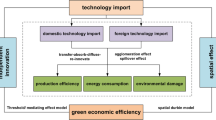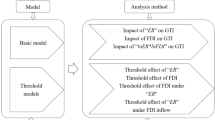Abstract
Over the years, foreign direct investment (FDI) has not only promoted rapid economic growth in China, but also affected the country’s environmental quality through technology spillover. This paper tests the variables that may affect the ability of green innovation by using the Granger causality test. It extracts the variables passed the test as input variables, selects the number of patents as output variable, and evaluates the efficiency of various provinces in mainland China by examining their yearly technological progress variables. At the same time, technological progress is defined and divided into capital and environmental factors, and then panel data using the variable coefficients model was used to fit influencing factors to obtain impact coefficients of capital and environment. On this basis, this paper makes the determination of membership to replace the general sense of ‘threshold’ value by using fuzzy theory and proposes the concept of the ‘comprehensive threshold’ of economic development and environmental protection. The results show that less than a quarter of China’s provinces have crossed the comprehensive threshold. Finally, based on the conclusions of quantitative analysis, some suggestions are proposed that the Chinese government ought to enact different strategies for the introduction of FDI according to different development situations of different provinces.




Similar content being viewed by others
Notes
Data are derived from “Global and Regional FDI Trends in 2010” issued by UNCTAD on January 17, 2011. The data are not including the financial sector, being US $101.10 billion and lower than the data released by the Chinese Ministry of Commerce on January 18, 2011.
References
Azman-Saini, W. N. W., Law, S. H., & Ahmad, A. H. (2010). FDI and economic growth: new evidence on the role of financial markets. Economics Letters, 107, 211–213.
Banker, R. D., Cao, Z. W., Menon, N., & Natarajan, R. (2010). Technological progress and productivity growth in the U.S. mobile telecommunications industry. Annals of Operations Research, 173, 77–87.
Bao, Q., & Lv, Y. (2010). FDI and Environmental pollution in China: an empirical study by China’s panel data of manufacturing sectors. Nankai Journal (Philosophy and Social Sciences), (3), 93–103.
Baumol, W. J., & Oates, W. (1988). The theory of environmental policy (pp. 20–38). Cambridge: Cambridge University Press.
Borensztein, E., Gregorio, J. D., & Lee, J.-W. (1998). How does foreign direct investment affect economic growth? Journal of International Economics, 45, 115–135.
Cao, H., & Xiang, Z. (2009). Research on assessment system of enterprise’s independent innovation capability. China Industrial Economy, 258, 105–114.
Chen, L., & Liu, Z. B. (2006). Local innovation capacity FDI spillover and economic growth. Nankai Economic Research, 3, 90–101.
Cheung, K. Y., & Lin, P. (2004). Spillover effects of FDI on innovation in China: evidence from the provincial data. China Economic Review, 15, 25–44.
Cook, W. D., & Seiford, L. M. (2009). Data envelopment analysis (DEA)—thirty years on. European Journal of Operational Research, 192, 1–17.
Diewert, W. E., & Fox, K. J. (2010). Malmquist and Törnqvist productivity indexes: returns to scale and technical progress with imperfect. Journal of Economics, 101(1), 73–95.
Gottwald, S. (2006a). Universes of fuzzy sets and axiomatizations of fuzzy set theory. Part I: model-based and axiomatic approaches. Studia Logica, 82(2), 211–244.
Gottwald, S. (2006b). Universes of fuzzy sets and axiomatizations of fuzzy set theory. Part II: category theoretic approaches. Studia Logica, 84, 23–50.
Granger, C. W. J. (1969). Investigating causal relations by econometric models and cross-spectral methods. Econometrica, 37(3), 424–438.
Grosskopf, S. (1993). Efficiency and productivity. In H. O. Fried, C. A. Knox Lovell, & S. S. Schmidt (Eds.), The measurement of productivity efficiency: technique and application (pp. 160–194). New York: Oxford University Press.
Grossman, G. M., & Krueger, A. B. (1991). Environmental impacts of a North American free trade agreement. NBER Working Paper.
Han, Y. J., & Lu, Y. (2008). Threshold effect, economic growth and environmental quality. Statistical Research, 9, 24–31.
Harold, C., & Runge, C. F. (1993). GATT and the environment: policy research needs. American Journal of Agricultural Economics, 75, 789–793.
Hatemi-J, A. (2012). Asymmetric causality tests with an application. Empirical Economics, 43(1), 447–456.
Jorgenson, A. K. (2009). Foreign direct investment and the environment, the mitigating influence of institutional and civil society factors, and relationships between industrial pollution and human health. Organization & Environment, 22, 135–157.
Kamalakanthan, A., & Laurenceson, J. (2005). How important is foreign capital to income growth in China and India? EAERG Discussion Paper Series with number 0405, East Asia Economic Research Group, School of Economics, University of Queensland, Australia.
Kemeny, T. (2010). Does foreign direct investment drive technological upgrading? World Development, 38, 1543–1554.
Kokko, A. (1994). Technology, market characteristics and spillovers. Journal of Development Economics, 43, 279–293.
Lozano, S., & Villa, G. (2010). Gradual technical and scale efficiency improvement in DEA. Annals of Operations Research, 173, 123–136.
MacDougall, G. D. A. (1960). The benefits and costs of private investment from abroad: a theoretical approach. Economic Record, 36, 13–35.
Marc Fetscherin, M., Voss, H., & Gugler, P. (2010). 30 years of foreign direct investment to China: an interdisciplinary literature review. International Business Review, 19, 235–246.
Matthew, A., Colea, M. A., & Fredriksson, P. G. (2009). Institutionalized pollution havens. Ecological Economics, 68, 1239–1256.
Nelson, A. J. (2009). Measuring knowledge spillovers: what patents, licenses and publications reveal about innovation diffusion. Research Policy, 38, 994–1005.
Pakes, A., & Griliches, Z. (1984). Patents and R&D at the firm level: a first look. In Z. Griliches (Ed.), R&D, patents and productivity, Chicago (pp. 55–71).
Qi, J. H., Zheng, Y. M., Laurenceson, J., & Li, H. (2009). Productivity spillovers from FDI in China: regional differences and threshold effects. China & World Economy, 17, 18–35.
Solow, R. M. (1957). Technical change and the aggregate production function. Review of Economics and Statistics, 39(3), 312–320.
Song, M. L., & Wang, S. H. (2010). Analysis of green innovation capability based on panel data in China. China Soft Sciences, 5, 143–151.
Walter, I. (1982). Environmentally induced industrial relocation to developing countries. In S. J. Rubin & T. R. Graham (Eds.), Environment and trade (pp. 67–101). Totowa, London: Allenheld Osman & Francis Pinter.
Walter, I., & Ugelow, J. L. (1979). Environmental policies in developing countries. Ambio, 8, 102–109.
Webber, M., Wang, M., & Zhu, Y. (2002). China’s transition to a global economy. New York: Palgrave Macmillan.
Zhang, Y., & Jiang, D. C. (2007). Regional difference and threshold effects of FDI technology spillovers. World Economy, 9, 101–111.
Zweifei, A. (2010). Productivity indices. Munich: GRIN Publishing GmbH. http://www.grin.com/en/e-book/154733/productivity-indices.
Acknowledgements
We would like to thank the supporting of Program for New Century Excellent Talents in University (No. NCET-12-0595), National Natural Science Foundation of China (71171001), Humanity and Social Science Youth Foundation of Ministry of Education of China (10YJC630208), Key Foundation of Natural Science for Colleges and Universities in Anhui, China (KJ2011A001), Soft Science Foundation of Anhui, China (12020503063), and Key Foundation of National research in Statistics of China (2011LZ023).
Author information
Authors and Affiliations
Corresponding author
Rights and permissions
About this article
Cite this article
Song, M., Tao, J. & Wang, S. FDI, technology spillovers and green innovation in China: analysis based on Data Envelopment Analysis. Ann Oper Res 228, 47–64 (2015). https://doi.org/10.1007/s10479-013-1442-0
Published:
Issue Date:
DOI: https://doi.org/10.1007/s10479-013-1442-0




